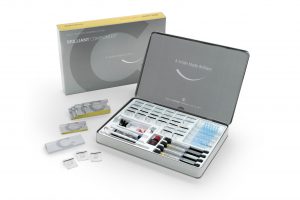The wide range of prevention – Mark Allen, General Manager at COLTENE
Featured Products Promotional FeaturesPosted by: Dental Design 8th November 2019

 When treating previously unrestored teeth, damage caused by primary caries is the reason behind most recommendations of restorative therapy.[i] Decay in permanent teeth is still the most prevalent oral disease worldwide, despite being one of the most preventable.[ii]
When treating previously unrestored teeth, damage caused by primary caries is the reason behind most recommendations of restorative therapy.[i] Decay in permanent teeth is still the most prevalent oral disease worldwide, despite being one of the most preventable.[ii]
In the UK, people are becoming more aware of the value of oral health and your patients may have a good idea of what ‘prevention’ means. If you asked them to tell you what they understand by preventive dentistry, they’d probably say things like “cleaning properly” “going to the dentist regularly” and “trying to avoid sugar”.
It’s not just about decay
But looking after your teeth means protecting them from non-carious damage that’s not related to decay. Non-carious defects include injury and lesions caused by erosion, abrasion and abfraction and can also necessitate restorative work to fix. So, a truly comprehensive and effective prevention message must cover these areas too.
Sometimes, a seemingly innocent habit can be the reason for tooth fracture or damage. For example, a recent survey shone a spotlight on the different ways that people misuse their teeth.[iii] Maybe you are guilty of some of these – who hasn’t held their keys in their mouth while trying to take shopping bags/children/dog out of the car? But the result could be an oral injury. Other results for alternative uses for teeth given included tearing Sellotape, habitual nail-biting and (horrifyingly) opening bottles. An ‘innocent’ pen chewing habit is far less innocent if a patient considers that the long-term abrasive action could lead to tooth wear which will need repairing by the dentist. If they have a problem with irritating food debris after eating, cleaning interdentally with something other than a properly designed tool is never a good idea, either. As a side note, a patient who experiences persistent food trapping might not realise that there could be a permanent solution to this problem, via restorative treatment.
The dental perils of an active life
At any age, damage to teeth can occur due to an avoidable injury. For example, dental injuries are common for anyone playing recreational sport, as well as elite athletes.[iv] Patients who regularly play sports should ensure that they don’t risk an avulsed tooth, because they haven’t protected their mouth and jaw correctly. A mouth guard should be considered essential in order to prevent damage caused by a heavy blow, including a fall. Mouth guards have come on a long way from the ‘boil and bite’ (and often uncomfortable) designs; they can now be custom made to fit the mouth exactly. Dental practitioners should tell active, sporty patients that they may need to think outside the box, too. Aside from the obvious activities like cricket, hockey, rugby and boxing where mouth protection is essential, non-contact sports also carry the risk of orofacial injury. A fall or collision during cycling could lead to a fractured tooth and a dental intervention. Interestingly, the American Dental Association recommends a mouth guard for all recreational sports.[v]
Aside from avoidable injuries, bruxism, excessive consumption of acidic food/drink, xerostomia (where the benefits of a healthy salivary flow are impeded) and over-zealous brushing are all factors for non-carious damage. Patients who brush too vigorously may think that by giving their teeth a good scrub that they are removing
the optimal amount of bacteria and debris – and enamel is tough enough to take it, right? But practitioners know that rough scrubbing can not only cause tooth wear but will also damage the delicate gum line. A recap of correct technique should be given at every maintenance appointment. Increased sensitivity, visible recession in the gum area and a toothbrush with frayed bristles well before the recommended three-month replacement time are signs of incorrect, over vigorous brushing that a patient should look out for. With dentally healthy patients only required to attend the dentist every
12 to 24 months, any changes – no how matter minor they seem – should prompt an appointment to ensure that there is no damage to the enamel. The use of abrasive cleaning products must be warned against too.
For dentists, they may find themselves recommending restorative treatment for non-carious damage, as well as dental injury. For a patient who cleans properly and visits the dentist regularly yet is frustrated about needing a tooth or teeth restored because of their grinding habit, they should be assured that there are minimally invasive, efficient treatment options available. COLTENE has a high-quality range of restorative products and materials, from the BRILLIANT Crios composite bloc (ideal for bruxism patients) to the BRILLIANT COMPONEER™ for speedy yet stunning chairside restorations, no laboratory necessary.

Patients need to understand that the preventive message encompasses a wide range of areas and is based on protecting and taking good care of their teeth as they would the rest of their body. Decay is preventable but avoiding other bad habits (even supposedly innocent ones) will preserve a healthy, beautiful smile.
To find out more visit www.coltene.com, email info.uk@coltene.com or call 01444 235486
References
[i] Nascimento MM, Gordan VV, Qvist V, Litaker MS, Rindal DB, Williams OD, Fellows JL, Ritchie Jr LK, Mjör IA, McClelland J, Gilbert GH. Reasons for placement of restorations on previously unrestored tooth surfaces by dentists in The Dental Practice-Based Research Network. The Journal of the American Dental Association. 2010 Apr 1; 141 (4): 441-8.
[ii] World Health Organization. Fact sheets on Oral health. Last updated 24 September, 2018. Link: https://www.who.int/news-room/fact-sheets/detail/oral-health (accessed June 2019).
[iii] Oral Health Foundation (2019). ‘National Smile Month Nationwide Survey 2019’, Atomik Research, May 2019. Link: https://www.dentalhealth.org/news/opening-bottles-tearing-clothing-tags-and-doing-up-zips-the-most-alternative-uses-for-our-teeth-revealed (accessed June 2019).
[iv] Saini R. Sports dentistry. National Journal of Maxillofacial Surgery. 2011 Jul; 2(2): 129.
[v] ADA American Dental Association. Five Health Organizations Double Down on Mouth Guards, 1 April 2016. Found at: http://www.ada.org/en/press-room/news-releases/2016-archive/march/five-health-organizations-double-down-on-mouth-guards (accessed June 2019).









